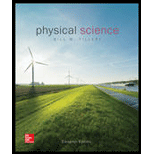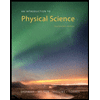
Physical Science
11th Edition
ISBN: 9780077862626
Author: Bill Tillery, Stephanie J. Slater, Timothy F. Slater
Publisher: McGraw-Hill Education
expand_more
expand_more
format_list_bulleted
Concept explainers
Textbook Question
Chapter 23, Problem 14AC
An intense low-pressure area with widespread winds greater than 120 km/h is a
a. tornado.
b. tropical storm.
c. hurricane.
d. cyclone.
Expert Solution & Answer
Want to see the full answer?
Check out a sample textbook solution
Students have asked these similar questions
Typical atmospheric pressure is 101,300 N/m2. Estimate the speed of the winds in a category 5 hurricane, where the pressure can be as low as 97,800 N/m2. Answer in m/s.
Please answer correctly
How much does a cloud weigh? Usgs.gov says that the average cumulus cloud (the big fluffy white ones) weighs 500,000 kilograms. Convert that number to pounds. Then put that value into a perspective you can visualize, such as comparing it to other objects you are familiar with. Show all your math. Do not just look up the value.
Explain how a supercell thunderstorm forms and how it is different from an ordinary thunderstorm.
Why do these storms typically have overshooting tops and produce hail?
Chapter 23 Solutions
Physical Science
Ch. 23 -
1. Condensation of water vapor into clouds or fog...Ch. 23 - Prob. 2ACCh. 23 - 3. Which is not an example of precipitation?
a....Ch. 23 - Prob. 4ACCh. 23 - Prob. 5ACCh. 23 - Prob. 6ACCh. 23 - Prob. 7ACCh. 23 - Prob. 8ACCh. 23 - Prob. 9ACCh. 23 - Prob. 10AC
Ch. 23 - Prob. 11ACCh. 23 - Prob. 12ACCh. 23 -
13. The separation of charge associated with the...Ch. 23 -
14. An intense low-pressure area with widespread...Ch. 23 -
15. A hurricane does not have
a. gale...Ch. 23 - Prob. 16ACCh. 23 - Prob. 17ACCh. 23 -
18. The source of energy that drives the...Ch. 23 - Prob. 19ACCh. 23 -
20. A thunderstorm that occurs at 3 a.m. over a...Ch. 23 - Prob. 21ACCh. 23 - Prob. 22ACCh. 23 - Prob. 23ACCh. 23 - Prob. 24ACCh. 23 - Prob. 25ACCh. 23 - Prob. 26ACCh. 23 - Prob. 27ACCh. 23 - 28. A cloud is hundreds of tiny water droplets...Ch. 23 - Prob. 29ACCh. 23 - 30. In order for liquid cloud droplets at the...Ch. 23 - Prob. 31ACCh. 23 - 32. Which basic form of a cloud usually produces...Ch. 23 - Prob. 33ACCh. 23 - Prob. 34ACCh. 23 - Prob. 35ACCh. 23 - The basic difference between a tropical storm and...Ch. 23 - 37. Most of the great deserts of the world are...Ch. 23 - 38. The average temperature of a location is made...Ch. 23 - Prob. 39ACCh. 23 - Prob. 40ACCh. 23 - Prob. 41ACCh. 23 - Prob. 42ACCh. 23 - Prob. 43ACCh. 23 - 44. Precipitation that is formed by cycling...Ch. 23 - 45. The smallest, most violent weather event is a...Ch. 23 -
1. What is a cloud? Describe how a cloud forms.
Ch. 23 - 2. What is atmospheric stability? What does this...Ch. 23 - Prob. 3QFTCh. 23 - Prob. 4QFTCh. 23 - 5. What kinds of clouds and weather changes are...Ch. 23 - 6. Describe the wind direction, pressure, and...Ch. 23 - Prob. 7QFTCh. 23 - 8. Describe the three main stages in the life of a...Ch. 23 - 9. What is a tornado? When and where do tornadoes...Ch. 23 -
10. What is a hurricane? Describe how the weather...Ch. 23 -
11. How is climate different from the weather?
Ch. 23 - Prob. 12QFTCh. 23 -
13. Identify the four major factors that...Ch. 23 -
14. Since heated air rises, why is snow found on...Ch. 23 -
1. Explain why dew is not considered to be a form...Ch. 23 - 2. What are the significant similarities and...Ch. 23 - Prob. 3FFACh. 23 - 4. Describe several examples of regional climate...Ch. 23 -
1. At a certain location, the surface temperature...Ch. 23 - 2. The surface temperature is 21°C, and the lapse...Ch. 23 - 3. A parcel of air with a volume of 5.2 103 km3...Ch. 23 - 4. A parcel of air with a volume of 9.1 104 km3...Ch. 23 - A parcel of air with a volume of 7.3 104 km3...Ch. 23 - Prob. 6PEBCh. 23 - 7. Atmospheric soundings from four weather...Ch. 23 - Prob. 8PEBCh. 23 - Prob. 9PEBCh. 23 - Prob. 10PEBCh. 23 - Prob. 11PEBCh. 23 -
12. The following table lists average monthly...Ch. 23 - Prob. 13PEB
Additional Science Textbook Solutions
Find more solutions based on key concepts
On cold, clear nights horses will sleep under the cover of large trees. How does this help them keep warm?
University Physics Volume 2
What discovery in the 15th century greatly advanced progress in science?
Conceptual Physical Science Explorations
5.106 A 70-kg person rides in a 30-kg cart moving at 12 m/s at the top of a hill that is in the shape of an arc...
University Physics (14th Edition)
An aluminum calorimeter with a mass of 100 g contains 250 g of water. The calorimeter and water are in thermal ...
Physics for Scientists and Engineers
1. Rub your hands together vigorously. What happens? Discuss the energy transfers and transformations that take...
College Physics: A Strategic Approach (4th Edition)
56. Global Positioning System. Learn more about the global positioning system and its uses. Write a short repo...
The Cosmic Perspective (8th Edition)
Knowledge Booster
Learn more about
Need a deep-dive on the concept behind this application? Look no further. Learn more about this topic, physics and related others by exploring similar questions and additional content below.Similar questions
- What three months are the peak season in the United States (a) for hurricanes? (b) For tornadoes?arrow_forwardWhat would be the classifications of the air masses that form over the following source regions? (a) Sahara Desert (b) Antarctic Ocean (c) Greenland (d) mid-Pacific Ocean (e) Siberiaarrow_forwardMinimum Hurricane wind speed, 120 km/hr converted to meters per secondarrow_forward
arrow_back_ios
arrow_forward_ios
Recommended textbooks for you
 An Introduction to Physical SciencePhysicsISBN:9781305079137Author:James Shipman, Jerry D. Wilson, Charles A. Higgins, Omar TorresPublisher:Cengage Learning
An Introduction to Physical SciencePhysicsISBN:9781305079137Author:James Shipman, Jerry D. Wilson, Charles A. Higgins, Omar TorresPublisher:Cengage Learning

An Introduction to Physical Science
Physics
ISBN:9781305079137
Author:James Shipman, Jerry D. Wilson, Charles A. Higgins, Omar Torres
Publisher:Cengage Learning
A Level Physics – Ideal Gas Equation; Author: Atomi;https://www.youtube.com/watch?v=k0EFrmah7h0;License: Standard YouTube License, CC-BY